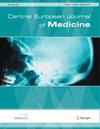Prognostic value of serum cystatin C levels in cirrhotic patients with normal serum creatinine
引用次数: 3
Abstract
Background/AimsAccurate assessment of renal function in patients with liver cirrhosis is difficult and of great prognostic importance. The present study aimed to determine the prognostic significance of certain renal markers and to investigate the priority of serum cystatin C (CysC) levels on one-year mortality in cirrhotic patients.MethodsRenal function of 45 liver cirrhotic patientss was evaluated by levels of blood urea nitrogen (BUN), serum creatinine (Cr), CysC, as well as 24-hour creatinine clearance (CCl) and estimated glomerular filtration rate obtained by Cockroft-Gault and MDRD formulas. The endpoint of the follow up was mortality within one year. Spearman’s correlation, linear regression analysis and receiver operating characteristic curves were used to investigate prognostic factors.Results42 men and 3 women (mean age 53.18 ± 9.71 years) were enrolled in the study. Eleven of the patients (24.4%) died as a result of liver cirrhosis within one year. In predicting mortality, levels of BUN, serum Cr and CysC showed area under the curves (AUC) values of 0.719 (95% CI, 0.539–0.899, p = 0.03), 0.726 (95% CI, 0.541–0.911, p = 0.026) and 0.770 (95% CI, 0.620–0.920, p = 0.008). Sensitivity and specificity of a CysC level of >1.3 mg/l in predicting mortality were 72% and 68%, respectively. Univariate regression analysis showed that elevated levels of CysC above the referent ones, increased the risk of one-year mortality nearly six times (p = 0.02, Exp (B) = 5.81).ConclusionsSerum CysC could be used as a good prognostic marker in patients with cirrhosis and normal Cr levels.血清胱抑素C水平对血清肌酐正常的肝硬化患者的预后价值
背景/目的准确评估肝硬化患者的肾功能是困难的,对预后具有重要意义。本研究旨在确定某些肾脏标志物的预后意义,并探讨血清胱抑素C (CysC)水平对肝硬化患者一年死亡率的影响。方法采用Cockroft-Gault公式和MDRD公式对45例肝硬化患者的肾功能进行评价,包括血尿素氮(BUN)、血清肌酐(Cr)、CysC、24小时肌酐清除率(CCl)和肾小球滤过率。随访的终点是一年内的死亡率。采用Spearman相关、线性回归分析和受试者工作特征曲线分析预后因素。结果男性42例,女性3例,平均年龄53.18±9.71岁。11例患者(24.4%)在一年内死于肝硬化。在预测死亡率时,BUN、血清Cr和CysC的曲线下面积(AUC)分别为0.719 (95% CI, 0.539 ~ 0.899, p = 0.03)、0.726 (95% CI, 0.541 ~ 0.911, p = 0.026)和0.770 (95% CI, 0.62 ~ 0.920, p = 0.008)。CysC水平bb0 1.3 mg/l预测死亡率的敏感性和特异性分别为72%和68%。单因素回归分析显示,CysC水平高于参考水平,一年死亡风险增加近6倍(p = 0.02, Exp (B) = 5.81)。结论血清CysC可作为判断肝硬化患者预后的良好指标。
本文章由计算机程序翻译,如有差异,请以英文原文为准。
求助全文
约1分钟内获得全文
求助全文

 求助内容:
求助内容: 应助结果提醒方式:
应助结果提醒方式:


